
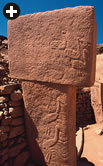 |
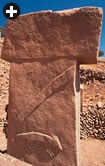 |
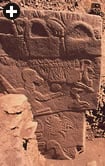 |
 |
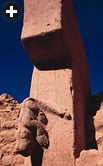 |
| Each slab taller than a person and sculpted with diverse animal images, the 11,600-year-old megaliths of Göbekli Tepe are arranged in circles—four have been excavated so far. Their T-like shape is believed to be a human effigy, with the crossbar representing the “head,” and “arms” made up of carving down the sides. The carved lion, far right, is a uniquely three-dimensional sculpture. |

 prawled before us today in the thirsty mid-morning heat of early September are dozens of megalithic monuments two to three meters high (6½-10'), arranged Stonehenge-like in four separate circles 10 to 30 meters (33-100') across. In the center of each stand two taller monoliths, their flat and faceless heads staring southeast over the vast Mesopotamian plain, where, it is generally accepted, the planet’s first agriculture bloomed. Sculpted onto most of the monuments are effigies of foxes, bulls, vultures, snakes, boars and spiders; one bears a highly artistic rendering of a feline resembling a lion. Chair-high rock benches link most of the standing stones and there are bowl-sized depressions in front of a few of the stones, possibly for offerings.
prawled before us today in the thirsty mid-morning heat of early September are dozens of megalithic monuments two to three meters high (6½-10'), arranged Stonehenge-like in four separate circles 10 to 30 meters (33-100') across. In the center of each stand two taller monoliths, their flat and faceless heads staring southeast over the vast Mesopotamian plain, where, it is generally accepted, the planet’s first agriculture bloomed. Sculpted onto most of the monuments are effigies of foxes, bulls, vultures, snakes, boars and spiders; one bears a highly artistic rendering of a feline resembling a lion. Chair-high rock benches link most of the standing stones and there are bowl-sized depressions in front of a few of the stones, possibly for offerings.
 |
| The stone circles lie on the north side of the “Hill with a Belly” (“Göbekli Tepe”), where the south side, above, is planted with young olive trees. To the right of the barbed-wire fence, ground-penetrating radar hints that as many as 20 more stone circles may lie buried. |
What is truly remarkable —and eminently arguable —is that these limestone pillars and their artwork may have been created by hunting-and-gathering peoples around 11,600 years ago, before the first fields of domesticated crops were planted anywhere in the world. However, no settlements that old have been found near the mound. Compounding the intrigue, the megaliths were intentionally—and perhaps ritually—buried under tons of fill 1500 years later, about the time the agricultural revolution was radically altering millennia-old ways of life in southeastern Anatolia.
Klaus Schmidt, a German archeologist who has been leading excavation work at Göbekli Tepe for 15 years, believes that what’s been uncovered here represents the world’s earliest known temple and its earliest known monumental art, neither of which has been previously associated with a hunter-gatherer way of life. Many prominent archeologists argue that only a settled farming culture could have mustered the resources and the large, organized work crews necessary to build the temple, but Schmidt thinks otherwise. “They were hunter-gatherers,” he contradicts affably. Schmidt, 53 years old and dressed in a long-sleeved shirt over loose jeans and dusty sandals, has been project director here since 1993, when he discovered what Howe had overlooked 30 years before. Affiliated with the University of Heidelberg and the German Archaeological Institute, he speaks about the place with an understated passion.
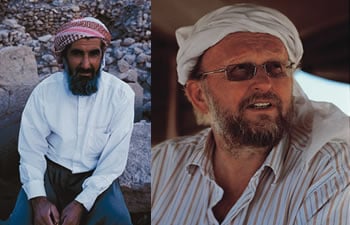 |
| Klaus Schmidt, above right, has been excavating annually at Göbekli Tepe for 15 years, after he leased the land from its owner Mahmut Yıldız, above left. |
His ardor is no surprise. Back in 1993, Schmidt was fresh from excavating the site Nevali Çori, 30 kilometers (19 mi) to the northwest, a rescue project now underwater behind the giant Atatürk Dam on the Euphrates. It had captivated him with its collections of T-shaped stones and he was soon on the hunt for more. When he came to Göbekli Tepe, he instantly recognized that the “gravestone” spotted by Howe was a larger version of those he had unearthed at Nevali Çori. Two other clues made him euphoric that day. Judging from the makeup of the soil at its top—clearly different from what lay below—the mound looked manmade; and it was covered with millions of flints and flint chips. That could mean only one thing: There was something spectacular beneath it.
“I knew then and there,” he recalls, his white headscarf flapping in the hot breeze, “that I had but two choices—go away and tell no one, or spend the rest of my life here.” Fortunately for academia, the world and Schmidt himself, he opted for the latter. After all, groundbreaking discoveries come to few archeologists in their lifetimes.
But he had to act fast—the mound was on private farmland. As evidenced by scrapes on the tops of some of the standing mega-liths, farmer-owner Mahmut Yıldız had already started plowing. But he signed a lease and Schmidt, under the auspices of the German Archaeological Institute and the Şanlıurfa Museum, set to hiring 50 workers from the village of Örencik just down the hill. Excavations began in 1994.
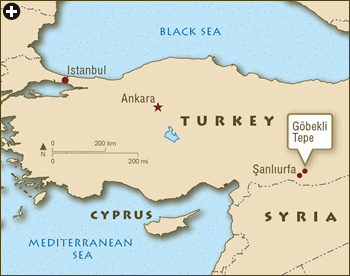 |
Schmidt paints a picture suggested by the stones’ shapes and their animal carvings. Supported by other leading researchers, he interprets the stones to be human effigies: The capitals form their heads, and arms are carved down their sides—similar to what he’d seen on later statues like those excavated at Nevali Çori. Quarried about a hundred meters (320') away, the giant, seven-ton limestone slabs (one of which still lies there, unfinished) were likely shaped with flints, dragged to the site, carved and erected. Broken flints are so ubiquitous it’s impossible to walk without treading on them.
By carbon-dating the layer of humus that has accumulated over the site since its intentional burial, and considering the tiny calcium-carbonate stalagmites on the stones, Schmidt has put that event at 10,800 to 10,000 years ago. But 1500 years prior to that, when the stones were erected, “there was a human and animal population explosion here,” he says. “It was the end of the Ice Age.”
Walking gingerly atop the baulks that separate each excavation unit, we arrive at a stone that Schmidt finds particularly intriguing. A busy scene is pecked into its west-facing side, and it seems to tell a complex story. “See these three images with the rounded tops?” the archeologist asks, pointing to a row of shapes along its top edge. “Each of those … is associated with a different element.” Sure enough, the first depicts a bird, the second an unidentified four-legged beast and the third a frog. “Air, earth and water,” says Schmidt convincingly. The story appears to continue below. A vulture, clearly identifiable by its hooked beak and claws, plays with a ball. “That’s the sun,” Schmidt continues. Summing up, he says the story represents the creation of the cosmos: the sun and three earthly elements. “At least, that’s our interpretation so far.
“There’s no doubt that it was religion that brought people together here,” Schmidt says, looking at the assemblies, which predate Stonehenge by some 6500 years. “It’s the first place that images of deities are seen.” He tells me that earlier art depicted natural things like animals and people. But here, he points out, there are three levels of symbolism: the human heads forming the capitals of the stones; the animals carved on their sides; and some non-human, non-animal symbols: an H-shaped icon and a round image with a quarter-moon shape beneath. But, he admits, “We really have no idea” what they mean overall.
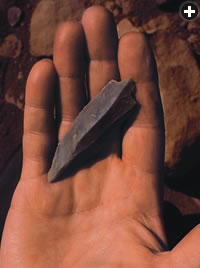 |
 |
| When Schmidt inspected the site in 1993, he found “millions” of flints and flint chips, top, which to his eye indicated that he could “go away and tell no one, or spend the rest of my life there.” Above: Work begins at 6:00 a.m. during each year’s dig season. |
Schmidt expects to find burials beneath the benches, much like those at Çatal Höyük, 120 kilometers (75 mi) to the west. He’s been cautious about digging so far, however. “As soon as you do that, you destroy a structure,” he says. The first look will probably come in this spring. Burials are a feature Ian Hodder, director of the Çatal Höyük project, would like to see, too. “It’s certainly possible they have burials,” says the Stanford University professor. “From my point of view, it would be nice if there were ancestral burial places because I think that’s what fits into what we’re finding at Çatal Höyük.” There, scores of burials have been found beneath benches in long-buried houses.
Most of the stones at Göbekli Tepe present hunting scenes. As with the “creation” scene, one stands out. Crunching over the ever-present flints, Schmidt shows me the “poison”-themed pillar. Several snakes, aligned with the penis of what looks like a fox, are wrapping themselves around the monolith; spiders crawl; and what Schmidt interprets as a poisonous centipede—the 42-legged version found in this part of Turkey—frames the scene.
What was going on here? Animal images from the Neolithic period frequently correlate with early religion, researchers say. “In tiered, shamanistic cosmologies, wild animals frequently come from god or a Lord of the Animals,” write David Lewis-Williams and David Pearce in Inside the Neolithic Mind: Consciousness, Cosmos and the Realm of Gods. “Hunting is therefore more than meat-acquisition …. It entails interaction with and acquisition of supernatural potency….”
Hunting and potency are seen as an underlying theme of the Göbekli Tepe images by other prominent Neolithic scholars. Hodder interprets the imagery as symbolizing danger, wild animals and male sexuality. “It’s a very sort of male/sexual/wild animal type of world,” he says. He links it with Çatal Höyük “in the sense that there may well be rituals in which male prowess was associated with killing wild animals and giving feasts. Social status was built in that way.”
And it was rituals and feasting that led to the first temple-building and crop domestication—not viceversa—argues another leading prehistorian. Brian Hayden, professor of archeology at Simon Fraser University in Canada, describes such feasting as “economically based competition,” which he says was a fundamental characteristic of all complex hunter-gatherer societies. Once established, “an entire array of prestige technologies develop to display the successful production and deployment of surpluses,” Hayden writes. “These include megaliths and massive architecture.” He argues that competitive feasting provided the conditions that required the investment of extra energy in the production of special foods. “Feasts were opportunities to vaunt one’s successes and were predicated on surpluses,” Hayden says.
This one-upmanship extended to hunting, Hayden adds. He thinks hunter-gatherers of the Upper Paleolithic (the period that immediately preceded the Neolithic) may have especially relished the meat of difficult-to-obtain wild cattle, either for its taste or its spiritual powers. Schmidt wouldn’t argue with that: He tells me the most prevalent bone remains found in the Göbekli Tepe fill are those of aurochs, an extinct species of ox and the progenitor of domesticated cattle. “Of all the species we’ve identified, aurochs are the only ones that required a communal effort to hunt—they needed the most complex techniques,” Schmidt says.
As for plants, Hayden contends that it’s not a big step from gathering to tending and selecting plants for desirable feasting properties. Of course, agricultural food production was much more labor-intensive than obtaining it from the wild. Since agriculture required clearing and spading ground, weeding, protection, harvesting and storing seed, the earliest domesticated plants were probably not used for everyday meals but reserved for special occasions like feasting.
From the mound’s windy top, Schmidt shows me what’s just on the other side to the north. There are more megaliths buried here, as yet untouched. The archeologist figures the entire site covers up to 36 hectares (90 acres), of which he’s dug just five percent. On this side, farmer Yıldız has already planted new fig and mulberry trees in two low-lying areas. Schmidt tells me that ground-penetrating radar and ground-resistivity tests in these bowls have revealed up to 20 more buried circles. But their excavation is some time off. “We still need another 10 years on what we’ve already found,” he says with a sigh.
Could even complex hunter-gatherer societies have organized the manpower to erect such a vast array of temple stones? “You don’t necessarily need a very large concentration of people to put these things up,” argues Andrew Moore, dean of graduate studies at Rochester Institute of Technology and an eminent prehistoric archeologist. He led excavations at the massive Neolithic site Abu Hureyra in northern Syria. “You can either have a lot of people working for a short period of time or relatively few people for a long period of time. That goes for other large projects as well, such as Stonehenge, the Pyramids or the Easter Island statues.”
Even so, Moore thinks it inconceivable that a megalithic site like Göbekli Tepe could have been built purely by hunter-gatherers. “It’s much more likely that they were also doing some grain-growing and stock-raising,” says Moore, who has dated grains of domesticated rye back 13,000 years at Abu Hureyra. “I imagine that there are settlements yet to be found in the [Göbekli Tepe] region within comfortable walking distance. Sites like this require some sort of base relatively nearby.”
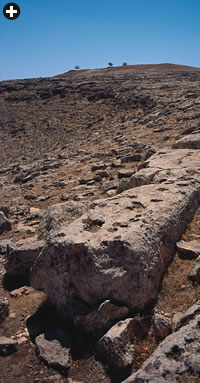 |
| Broken, too large, or just abandoned, a seven-meter (21') unfinished megalith lies where it was quarried, not far from the stone circles of Göbekli Tepe. |
Schmidt claims it would have been possible to raise a large workforce here without fixed farming settlements. “Hunter-gatherers wouldn’t have to range very far,” he says. “This was a very rich area for game. There was probably a high density of hunter-gatherers around.” Moreover, he figures there was likely a semi-permanent settlement where present-day Şanlıurfa sits, which he thinks would have been the closest significant water source. “That’s only 10 kilometers (6 mi) as the crow flies,” he says. “And we’re only a few days’ walk from Mureybet [a similarly dated Neolithic settlement on the Syrian Euphrates],” he adds with a sweep of his arm to the southeast. “They were hunter-gatherers, they were in top physical condition, and they could easily have come here regularly to build this temple and to work.”
Schmidt makes a good point. Several affluent sedentary hunter-gatherer cultures existed in prehistoric times that never developed agriculture, even though conditions would readily have permitted it—those of the coastal and riverine areas of Australia, California and British Columbia are among the examples.
It’s one of those long-standing arguments in archeology: the right conditions for agriculture are generally agreed upon, but how and why it started independently in different parts of the world are not. Along with the Fertile Crescent of South-west Asia, agriculture blossomed independently in at least four other regions: the Yangtze and Yellow River basins of China, the interior highlands of New Guinea, the tropical regions of the Americas, and the eastern woodlands of the us. Strong evidence for farming also comes from central sub-Saharan Africa and southern India.
Climatic conditions were clearly favorable for the development of agri-culture in southeastern Anatolia when Göbekli Tepe was built. About 11,500 years ago, the weather in much of the world became warmer, wetter and more consistent. Here in Turkey’s Urfa Province, the land was well-vegetated; it sloped to the south, ensuring maximum sun exposure; hot, dry summers followed by wet winters made it ideal for farming.
Did farms evolve around this magic mound before, during or after its hey-day? Ofer Bar-Yosef, MacCurdy Professor of Prehistoric Archeology at Harvard University, holds that farmers were here first. The development of domesticated crops was a long drawn-out process, he argues: “Early farming was based on wild plant species cultivated every year for at least a thousand years before 60 to 80 percent of the plants in a given field were domesticated. Even the earliest published carbon-14 dates for Göbekli fall after several centuries of established farming had already taken place in south-eastern Turkey.”
Bar-Yosef differs from some theorists on the critical mass needed for the Göbekli workforce. “You have to have a large population to build such a thing,” and that’s predicated on farming, he says. “You have to have someone allocating the jobs, tending the people, feeding the people and so on. So this is a good indication for a social society that built it.”
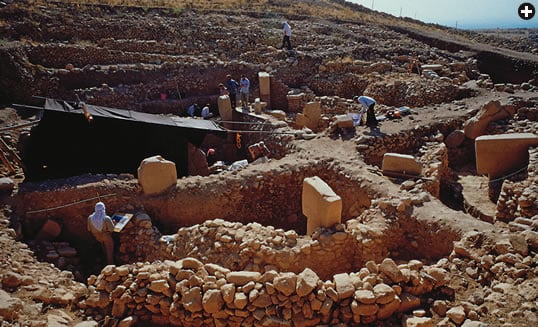 |
| Why was Göbekli Tepe buried about 1500 years after it was constructed? Did farms evolve around this mound before, during or after its heyday? There are at present no clear answers, only hypotheses. |
Indeed, recent microscopic studies of how cereal ears break apart naturally and the different way they shatter during harvest have provided a way to tell cultivated from uncultivated grains, and confirmed that several varieties of wheat had been domesticated at nearby Çayönü, a Neolithic site to the northeast, by the second half of the ninth millennium BC—the oldest convincing signs of cultivated wheat. Schmidt acknowledges that cultivation may have been under way at the time that religious ceremonies associated with Göbekli Tepe were unfolding, but he is uncertain as to its extent. He directs my gaze to a range of low hills to the northeast, the Karacadag Mountains, where Çayönü is nestled. Einkorn, the earliest species of cultivated wheat, is found there in both wild and domesticated form, he explains. One theory, in line with that of Simon Fraser University’s Hayden, is that people traveling to the Karacadag Mountains to gather einkorn dropped some near Göbekli Tepe, where religious revelers noticed it sprouting. This led them to think about growing einkorn there rather than traveling so far to find it.
Traditionally, theories of the origins of food production have been based on human need: response to population pressures or other causes of resource imbalances. But as studies have advanced, no evidence of resource stress or malnutrition has been found in places where farming has bloomed, fueling new theories and debates.
But there’s little debate that the Neolithic period was truly a time of revolutionary change for humankind, not only in technology and ways of life, but religiously and spiritually. Jacques Cauvin, the late director emeritus of research at the Centre National de la Recherche Scientifique in Paris, a leading scholar of the early Neolithic period in the Near East, called it a complete restructuring of human mentality, expressed in new religious ideas and symbols. Göbekli Tepe was front and center in that timeline.
The Neolithic revolution saw both highly developed religious ideology and mixed farming take a firm hold throughout the Middle East. Cauvin viewed the finds at Göbekli Tepe and the later sites of Çayönü and Nevali Çori as evidence of rooted communities with a religious bent. “We encounter for the first time simultaneous evidence for public buildings and for the collective ceremonies of a religious character that took place in them. These must have served as a strong cement for the psychological cohesion of these sedentary human groups,” he wrote in The Birth of the Gods and the Origins of Agriculture. “It is also quite probable that they were addressing … a personal divinity.”
As agriculture took root, it had a powerful impact on these religious themes. “It seems probable that at sites such as Göbekli Tepe and ‘Ain Ghazal [an early Neolithic village in Jordan], myths featured protagonists who mediated the hunting/farming dichotomy…,” write David Lewis-Williams and David Pearce.
The switch from pure hunting and gathering to farming was surely a profound change. Says another Neolithic researcher, Peter Bellwood of Australian National University, “There are obviously many aspects of mobile hunter-gatherer society that are antithetical to adoption of the sedentary lifestyle of the cultivator. On top of this, we have the attitudes of the farming and pastoralist societies themselves, often ranked and status-conscious, with whom some of the ethnographic hunter-gatherers have come into contact and by whom many have eventually been encapsulated.”
 |
| So far, each slab’s design is unique: Still half-buried, this one appears to sprout the very leaves that could symbolize the onset of a plant-based food economy, a recognition of the slow transition, over millennia, that humans would later name “the Neolithic Revolution.” |
Schmidt holds that such differences led to the loss of the idyllic hunting-and-gathering way of life around Göbekli Tepe and the laborious ritual burying of the site. Harvard’s Bar-Yosef disagrees, although he acknowledges the events may be related. Like Andrew Moore at the Rochester Institute of Technology, he believes that farming and hunting were carried out simultaneously at Göbekli Tepe. “They were already farmers, and farmers go hunting,” he says. “It’s something so natural to humans, so they were not terminating this [when they buried Göbekli Tepe]. They were terminating different things, related … to their own society in the social structure and in the belief system.” With the onset of domesticated crops, the real gods may have changed—perhaps to those of the rain or of the land. “So they got rid of all the old ones,” he says.
Hodder says that fits in very well with what his team has found at Çatal Höyük and what has been observed at Çayönü and a number of other sites: “It’s a very careful ending and filling in and rebuilding, either on top or somewhere else. It’s all about creating continuity and building histories through time. They were obviously very fascinated with creating continuities through time so the ending and beginning of something is very important—they have very elaborate processes of filling in and starting again.”
At Çatal Höyük, houses were buried at the end of their life-span when they were no longer useable. “I don’t know whether [the pillars at Göbekli Tepe] would have had lifespans or not, whether the roof would fall off, or they would become too small for their purpose or what it might be,” Hodder says.
Whatever spelled the beginning—and the end—of Göbekli Tepe’s temple, it was epic. “This is a very spectacular discovery,” says Moore. “One day, once we better understand what’s going on here, we’re going to look back and say this extraordinary find really did transform our ideas about the early stages of the Neolithic Near East.”

 n the winding cobblestone streets of old Şanlıurfa, too narrow for cars, little has changed since medieval times. Halfway up a street named Nabi Sokak, a low door leads to the stone courtyard of the house that belongs to Klaus Schmidt and his wife, and which doubles as the Göbekli Tepe project dig house. Schmidt’s marriage to Turkish archeologist Çigdem Köksal parallels the project: They met at Göbekli Tepe during the first year of excavation and she has become an integral part of the project, especially in liaising with local tourism authorities.
n the winding cobblestone streets of old Şanlıurfa, too narrow for cars, little has changed since medieval times. Halfway up a street named Nabi Sokak, a low door leads to the stone courtyard of the house that belongs to Klaus Schmidt and his wife, and which doubles as the Göbekli Tepe project dig house. Schmidt’s marriage to Turkish archeologist Çigdem Köksal parallels the project: They met at Göbekli Tepe during the first year of excavation and she has become an integral part of the project, especially in liaising with local tourism authorities.
A few years ago, Şanlıurfa’s Culture and Tourism Directorate picked up an idea from a story in Germany’s Der Spiegel newsweekly: It was about how the two central statues in each circle at Göbekli Tepe represented Adam and Eve in the Garden of Eden. The directorate decided to use the theme to attract tourists to the site.
“It was an absolute fabrication,” asserts Schmidt over our starter of mercimek Çorbas?, a savory lentil soup. “We don’t support it at all—there’s no connection whatsoever.” Köksal-Schmidt says she has convinced the authorities to forget the idea of publicizing such an interpretation of the site.
Schmidt agrees that the world-class status of the temple warrants its promotion as a tourist attraction, but he wants it to happen in a controlled way. An application to unesco to make Göbekli Tepe a World Heritage Site is already under way. “I don’t want to turn Göbekli into a Disneyland,” says Schmidt, who has been pressured to excavate faster to get the attraction up and running for tourists as soon as possible. He and his wife have had to deflect this as well. “Excavation cannot be hurried,” Schmidt says. “The site needs protection. We can’t have people tramping around the site unsupervised.”
Already, buses roll up to Göbekli Tepe regularly to unload tourists and guides. Schmidt says he’d rather have an interpretation center with regular hours set up a few kilometers from the site itself, perhaps with reproductions of the stones.
Earlier in the day, he had shown me how. We walked past a stone that was shielded with black cloth: A crew was laser-scanning the monument. The digitized data are fed to a rock-carving machine that can chip out faithful reproductions of the stone in any size. “We have already done three of them,” Schmidt says. The reproductions have been shipped to the Şanlıurfa Museum, but it’s not yet certain where the museum plans to set them up.
 |
Free-lance writer Graham Chandler (www.grahamchandler.ca) focuses on topics in archeology, aviation and energy. He received his doctorate in archeology from the University of London and lives in Calgary, Alberta. |
 |
Writer and photographer Ergun Çağatay lives in Istanbul. He is the co-editor and photographer of The Turkic Speaking Peoples: 2,000 Years of Art and Culture from Inner Asia to the Balkans (Prestel). |